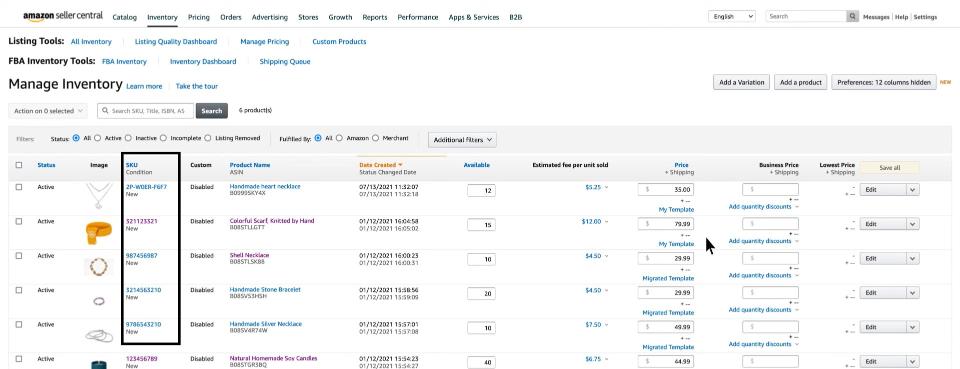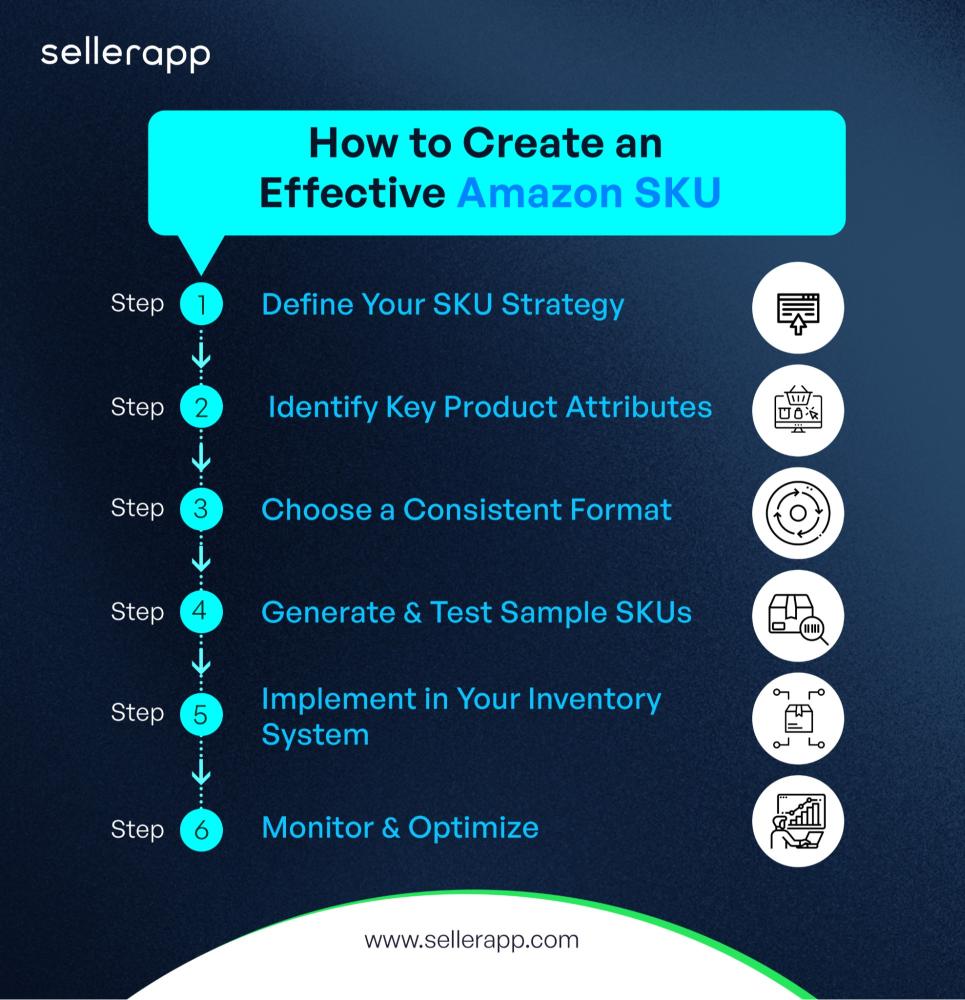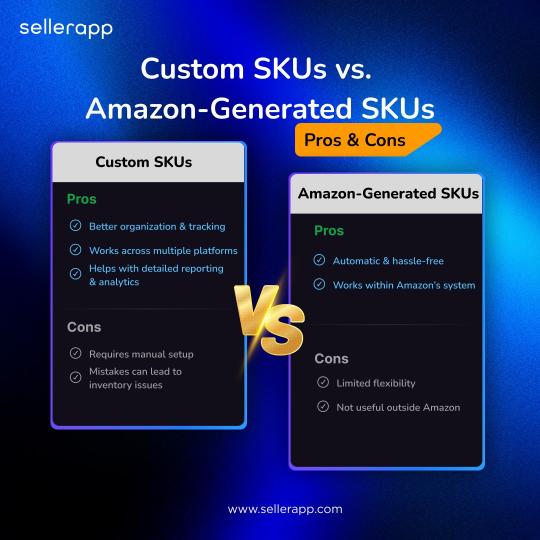What is Seller SKU on Amazon and How to Create One?

If you’re looking for a better understanding of “What is Seller SKU on Amazon?” chances are you’re new to the world of Amazon and planning to build a successful business. To get your products listed, it is essential to abide by Amazon’s rules. Thus it is essential to have SKUs for all your products and their variations.
SKUs help you keep proper track of stock levels and ensure efficient operations. But how does that directly influence your business?
In this article we will dive deep into what is a seller SKU on Amazon, why is it important, how it works, different ways to obtain or customize an SKU, and how SKUs differ from other identifiers— consider it all covered!
What is seller SKU on Amazon?
SKU is an abbreviation for stock keeping unit, a unique code that differentiates products from similar products from other sellers. It ideally comprises 8-10, alphabets and numbers in different combinations. It is visible in your Seller Central Account among your listings.
To make the best use of this feature, have SKUs allotted for each variation of all the products that you’re selling.
Say you have 30 varieties of coffee mugs in your Amazon storefront, each of which comes in 5 different colors and 2 size options. Then you should ideally have a total of 300 SKUs for your inventory to have a clearer view of stocks.
Is an SKU the same as a barcode on products?
No, seller SKU is unique to online selling across multiple channels, unlike the universal barcode.
Do I need a SKU to sell on Amazon?
Creating SKUs for each listing is essential while you have the complete freedom to choose the format or structure of the product SKUs. Otherwise, Amazon will auto-generate one which might not suit your management needs.
Seller SKUs on Amazon can neither be recycled nor can be changed once assigned to a product.
It might not be essential to you if you plan to not extend your inventory. But as your product offerings diversify, keeping track of inventory movement becomes a confusing affair. That is where the concept of seller SKU on Amazon comes in, allowing us to better distinguish products, monitor stock movement, and accept orders. So a familiar format of SKU makes products recognizable— at least to management and third parties involved.
However, Amazon needs to differentiate products in terms of sellers, varieties, etc. for which your unique SKU sets you apart.
How do Seller SKUs on Amazon work?
Now that you’ve understood what is seller SKU on Amazon? Let’s take a look at how it works.
When a purchase is made, the decrease in stock is directly reflected in the inventory level records in your Amazon Seller Central account. On Amazon storefront, it displays a clear picture of what products are available for purchase.
For sellers using third-party storage or delivery fulfillment services, it is especially useful for easier communication while handling an extensive inventory. This practice fosters complete transparency and thus keeping a record becomes effortless.
Various sellers can sell one product on Amazon; SKU helps the order processing system differentiate that. The system thus keeps track of which variant is having higher demand, suggesting when to stock up the inventory ultimately giving you necessary estimates and insights.
Amazon assigns a unique SKU automatically in case sellers avoid customizing and adding it during listing.
For example, BL-W-300 can easily be identified as a bowl, white in color with a capacity of 300 cc. But, when Amazon assigns an SKU to the same bowl, it is L67-DFY789-EF34— completely unrecognizable!
Like in this image, the seller SKU on Amazon does not have segregated components suggesting that it was automatically generated by Amazon.

Why Do You Need the Seller SKU on Amazon?
If Amazon is making it compulsory for sellers to come up with an SKU, you must know why it holds the weightage. Let’s take a look at the most prominent benefits of SKUs, elaborately.
#1. SKU is necessitated by Amazon
Starting with the obvious. Having an SKU is mandatory for Amazon sellers.
To understand what is the seller SKU on Amazon, you need to first consider the multitude of listings available. One product can be attributed to different sellers and it can come in multiple different variants.
To prevent different listings from appearing similar, having a seller SKU on Amazon was made mandatory. It is more important for Amazon’s algorithm to identify product variations. Amazon’s algorithm also relies on SKU data to recommend and optimize strategies
#2. SKU for easy identification and tracking
The unique combination of alphanumeric characters that makes up the SKU of products helps in easy detection by the system. It sets each of the items apart leaving no place for confusion between sellers or product variants.
Understanding what is seller SKU on Amazon is also crucial in tracking purchasing behavior, and warehouse activities for Amazon FBA, and when considered with other metrics such as UPCs it causes easy visualization of sales across different platforms.
#3. Streamlined database management
Due to easy identification of products data management becomes streamlined. It speeds up the data entry action. As it acts as a shorthand, for sellers like you, it can help you organize your inventory without you requiring to add trivial details to the product name.
It is particularly helpful if you’re using data management software for inventory as it provides the system with a complete product description without including every detail.
For example, CP-BL-PU-U-2009 can represent a cap that is blue, unisex, from Puma and a 2009 model; instead of describing it, you simply enter CP-BL-PU-U-2009 and the system will detect it.
#4. Better communication
Amazon’s tracking system uses SKUs as an identifier, thus it is embedded into the system once assigned to a product making tracking easier. This leads to more accurate assistance and a clear reference during internal communication regarding specific products.
Amazon seller SKUs components
As mentioned earlier, creating a seller SKU on Amazon should be far from random. Since it is specifically designed for better product identification and differentiation, sellers like you must make complete use of the freedom. How? Let us explain.
Remember, not all components listed are necessary for your business.
- Broad descriptors: The SKU starts with it which describes the Amazon category it belongs to. For example, GT for Gardening tools.
- Special characteristic: This specifies the size, color, prints, etc.
- Seasonal identifiers: Having a seasonal identifier can help you easily identify the products from your inventory that are eligible for end-of-season sales. Or during a seasonal demand surge, you can increase their prices by 15-20% incrementally to gain a higher profit percentage.
Eg: WR for Winter, HLD for Holiday.
- Condition identifiers: This can highlight specific conditions related to your product to crosscheck its legitimacy in case of an inquiry or validate a product return.
Eg: NW or NEW for new products and REF for refurbished products.
- Cost identifiers: Cost identifiers can be MRPs, selling prices, or initial costs. These can be added as well to set a limit.
Eg: If considering an exact cost bracket as an identifier you can use ‘C80’ as a component for the product which lies within the $76-80 bracket. For a profit margin-based identifier may look like ‘HM’ i.e., high margin which may signify a margin above 50%.
- Supplier or Manufacturer: Adding this identifier within the SKU will promote brand consistency, and better communication making sure there is streamlined inventory management. Say, your supplier is Xu Mei Store from Alibaba, you can add XM within the seller SKU on Amazon to communicate better or keep track.
- Warehousing: It will easily tell you where a variation of a product is stocked and where it is exactly located, in case it is relevant to your logistic structure. You can use its warehouse code as well. The warehouse situated in 07016 can be added as ‘NY16’ as a component within the SKU.
- Date entered into inventory: When a product variation is assigned to a registration date, it can also be used in SKU creation.
A refurbished black leather jacket of size L, from 2023, costing $79.99, with a 50% margin from warehouse number LA12, can look like ‘WI23-JKT-BLK-L-REF-C80-HM-LA12’
- Sequential numbers: These are essential to separate older and newer listings from the inventory. For example, 0034 will signify a significantly older item from the stock in comparison with 0109.
Seller SKU on Amazon once created cannot be altered; so be mindful while creating and entering it. To alter it you’ll have to delete the listing and recreate it. Additionally, keep the feature codes consistent and maintain a track record of it.
Best practices for creating Amazon SKU
It takes very little brainwork to create Amazon seller SKUs when you think by keeping these best practices in mind.
- Although the character limit is 40, make sure you don’t increase the characters without necessity. The shorter the SKU the easier it is to manage. Best practice includes keeping it within 8-10 characters.
- One SKU for one particular product variant only.
- Make sure you design a format or sequence that you’ll follow throughout for all your products. Have it documented so that people associated with the management are well acquainted with the pattern.
- One commonly noticed confusion is the use of capital ‘i’ which resembles number 1 and capital ‘o’ which resembles the number 0.
- Never start your Seller SKU on Amazon with a Zero. If you’re using MS Excel, chances are it will completely omit the Zero at the beginning of an alphanumeric.
- Using all capital letters is a widely used practice.
- Underscore ‘_’ or period ‘.’ is used to separate components of SKU assigned to separate attributes.
- We recommend not to use other special symbols.
- Remember, the simpler the better.
- We do not recommend using dates as they may not stay relevant when new stocks are added. This will require another fresh product listing which may require unnecessary efforts.
Difference between Amazon SKU and other popular identifiers
| Feature | Amazon SKU | ASIN | FNSKU | GTIN | UPC |
|---|---|---|---|---|---|
| Full form | Stock Keeping Unit | Amazon Standard Identification Number | Fulfillment Network Stock Keeping Unit | Global Trade Item Number | Universal Product Code |
| Creator | Seller | Amazon | Amazon | GS1 | GS1 |
| Length | <40 characters | 10 characters | 10 characters | 8-14 digits | 12 digits |
| Purpose | Internal inventory management | Amazon product identification | Amazon fulfillment tracking | Global product identification | Retail barcode representation |
| Visibility | Internal | Customer-facing on Amazon | Internal to Amazon fulfillment | B2B and retail | Customer-facing in retail |
| Uniqueness | Unique to seller | Unique on Amazon | Unique per seller per product on Amazon | Unique | Unique |
| Customizable/Auto Generated (during creation) | Customizable | Auto Generated | Auto Generated | Auto Generated | Auto Generated |
| Required for Amazon Listing | No | Yes, assigned by Amazon | Yes, required for FBA | Often used interchangeably with UPC | Often used interchangeably with GTIN |
| Used Beyond Amazon | Yes | No | No | Yes | Yes |
How to create a seller SKU on Amazon

Creating an SKU is a fairly simple process. The biggest rule is to understand your convenience.
So there are two ways of having SKUs for your Amazon products. You can create it manually at your convenience, or Amazon will do it for you.
Customized SKU
This is preferred by sellers with a vivid catalog. Having more varieties makes it difficult to keep track and there come the SKUs, simplifying the entire process. It is especially helpful for sellers who carry out their own inventory management and fulfillment.
Step 1: Choose a broader category
- Based on the general category it falls in, pick a couple of characters.
- Say we are choosing an SKU for a pink Shirt of size M, the broader category can be rightly expressed as SH.
Step 2: Do deeper into Sub category or variation
- The variation of a pink Shirt of size M can be PKM
Step 3: Mention the collection
- A pink shirt of size M can be from the Springsumer ‘24 collection. So we can further add SS24 to the tail of the SKU.
Step 4: Add further details
- If it has bird prints add “BRP”. But make a note of every subsequent bird-printed clothing to have this abbreviation. This is how you create a successful SKU pattern.
Step 5: Separate the abbreviations with a character
- Place ‘PK’, ‘SH’, ‘PK.M’, ‘SS24’, and ‘BRP’ side by side spaced with a hyphen, creating PK-SH-PKM-SS24-BRP as a complete SKU for the product.
So, that’s how, for you to identify a product, you create a format for SKU creation under your storefront. This must have now solidified your idea about what a seller SKU on Amazon is and how it is rendered when customized. It well represents the M-sized pink shirt from Spring Summer ‘24 with bird prints on it.
Going into such depth with product variety is entirely optional— if you have a larger catalog you need more details to differentiate, while for smaller collections of offerings, it is not.
You can enter the self-created seller SKU on Amazon while listing a product.
Amazon-created SKU
Amazon can identify products using SKU so it is an essential part of the listing. If you fail to leverage the freedom to create your product SKUs, Amazon will assign one for every listing.
Curious about how it works? Let us show you how:
- Log in to your Amazon Seller Central account and open the dashboard.
- From the Sidebar (represented by three horizontal lines), tap ‘Inventory’.
- Create a new listing by tapping ‘Add a Product’.
- Fill in the required details and there Amazon will ask for your choice of SKU. If you feel like it’s okay for you to not have control over it, you better let Amazon do it for you. Leave it blank.
- End the product listing process by clicking on ‘Save and Finish’.
To find your Amazon-generated SKU you can go to the product listing on Amazon Seller Central platform. If you’ve been wondering ‘what is seller SKU on Amazon Central’ now you have your answer.
Now let’s address the elephant in the room.
Should I let Amazon create my SKUs for me?
Well, there is no hard and fast rule that you’ll have to customize the SKUs. What is seller SKU on Amazon? A simple identifier of your product. Amazon-generated SKUs are randomly automated and do not consider your choice for assigning an SKU. So if it does not let you have complete control over the curation, it loses the convenience factor. If that does not bother your action plan for your business, you should let Amazon create your SKUs.
Amazon Generated SKUs vs Customized SKUs

Let’s quickly compare the outputs of both methods:
| Feature | Amazon-Generated SKU | Self-Generated SKU |
|---|---|---|
| Control | Limited control over SKU composition | Complete control over SKU structuring. |
| Tracking | More challenging to track due to randomness and no clarity | Easier to track due to the familiar format. |
| Consistency | It results in having different SKUs for the same product variant across different selling channels. | Consistency across all marketplaces |
| Ease of Use | No effort required | Requires more effort |
| Identification | Difficult | Quick identification |
Final Thoughts
Having a seller SKUs on Amazon is a small step that can greatly impact business operations, managing stockouts or overselling—simply by simplification of product attributes and opening up easy routes of communication. Unique to sellers and variations, and customizable, it not only brings ease to the Amazon system to recognize but also to the members involved. Follow this guide to successfully customize SKUs for your catalog. Happy Brainstorming!
Additional Readings:
How to Sell on Amazon as an Individual Seller
Streamlining Amazon Order Management: Best Practices for Success
Understanding Amazon Best Seller Rank: A Comprehensive Guide
Cross Selling and Upselling on Amazon
10 Mistakes Amazon Sellers Need to Avoid at All Costs











Colton Jordan
April 12, 2025Thanks for simplifying the concept of SKUs. Your examples made it really easy to follow.